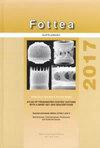Seminavis aegyptiaca sp. nov., a new amphoroid diatom species from estuary epilithon of the River-Nile Damietta Branch, Egypt
IF 1.4
3区 生物学
Q3 PLANT SCIENCES
引用次数: 4
Abstract
During a recent floristic-taxonomic study on the algal flora, including diatoms, from the estuary of the Damietta Branch of the Nile in Egypt, an interesting epilithic diatom species belonging to the genus Seminavis (Naviculaceae) was collected and investigated using both light and scanning electron microscopy. This new diatom species shares morphologically some taxonomic diagnostic features with other related taxa such as S. insignis, S. robusta, and S. ventricosa. However, it still differs by having ventral central striae that are shorter and more or less straight in the middle of the smaller frustules to be clearly radiate in the larger ones and then become geniculate and only radiate near the poles, the central raphe endings are externally more distantly spaced than in the similar species, the elongate central nodule is internally less prominent, and the areola density is much denser. Therefore, we here describe it as Seminavis aegyptiaca sp. nov. Hydrochemical analyses revealed that S. aegyptiaca commonly inhabits typical marine, with a weak tendency towards brackish water, habitats. It was found to be tolerant to meso-eutrophic, nutrient-enriched conditions, based on the data available on seasonal concentrations of N and P compounds. These findings not only contribute to the inventory of Egyptian diatoms, but also increase our understanding of the autecology and distribution of this relatively poorly-known diatom genus.埃及尼罗河达米埃塔支流河口巨角藻两性硅藻一新种
在最近对埃及尼罗河达米埃塔支流河口的藻类植物区系(包括硅藻)进行的植物区系分类研究中,我们收集了一种有趣的硅藻属(Naviculaceae),并使用光学和扫描电子显微镜对其进行了研究。这一新硅藻种在形态上与其他相关的硅藻类群如S. insignis、S. robusta和S. osa具有相同的分类诊断特征。然而,它的不同之处在于,在较小的结果中间有较短的或多或少直的腹中央纹,在较大的结果中有明显的辐射,然后变成弯曲的,只在两极附近辐射,中央缝的末端在外部比类似的物种间隔更远,细长的中心结节在内部不太突出,乳晕密度更密集。水化学分析结果表明,埃及沙蝇一般生活在典型的海洋生境,有向咸淡水生境的微弱倾向。根据现有的季节氮和磷化合物浓度数据,发现它对中富营养化、营养丰富的条件具有耐受性。这些发现不仅有助于埃及硅藻的清查,而且增加了我们对这种相对不为人知的硅藻属的起源和分布的了解。
本文章由计算机程序翻译,如有差异,请以英文原文为准。
求助全文
约1分钟内获得全文
求助全文
来源期刊

Fottea
生物-植物科学
CiteScore
4.00
自引率
9.10%
发文量
20
审稿时长
>12 weeks
期刊介绍:
Fottea is a journal of Czech Phycological Society (formerly bulletin Czech Phycology). Fottea publishes papers on all aspects of the ecology, physiology, biochemistry, cell biology, molecular biology, systematics and uses of algae (including cyanobacteria)
 求助内容:
求助内容: 应助结果提醒方式:
应助结果提醒方式:


